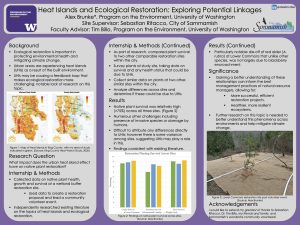Heat Islands and Ecological Restoration: Exploring Potential Linkages
In an era of significant environmental change as a result of anthropogenic activities, work that serves to protect the environment – such as ecological restoration – is more important than ever. Ecological restoration promotes biodiversity, regulates climate, and helps protect natural hydrological cycles. Urban heat islands (UHIs) are one such environmental change, describing the phenomena where urbanized areas experience higher temperatures than surrounding natural areas. I interned with the city of Sammamish on a wetland buffer restoration project and, noting the lack of research on the topic, conducted research with a guiding question of: What impact does the urban heat island effect have on native plant restoration? The aim of this study was to help understand if UHIs are affecting restoration work so that restoration ecologists can maximize the time and money they spend restoring native habitat successfully. I collected data from three restoration sites of similar age across the city of Sammamish and compared plant survival across the three different locations, looking for any differences that could be attributed to local temperature. It was difficult to account for all variables present, and while I cannot attribute these results directly to UHIs without further investigation, it is likely that native plants struggle more when exposed to higher temperatures. Further research is needed in order to better understand the interaction between these phenomena, ideally with a larger sample size and greater variance among UHIs. Ultimately, improving scientific understanding will lead to more effective restoration projects and a healthier, more resilient environment.
